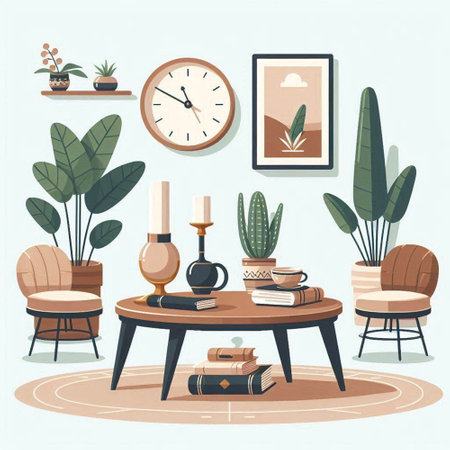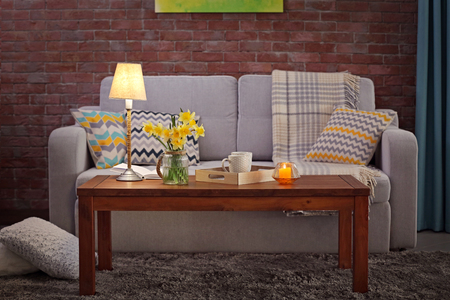Understanding the British Light
British homes are unique in how they interact with light. The UK’s ever-changing daylight—often filtered through overcast skies—plays a crucial role when choosing paint and soft furnishings. Unlike sunnier climates, where bold colours stay true throughout the day, British interiors must account for the subtle, sometimes moody quality of natural light. North-facing rooms tend to feel cooler and can make colours appear more muted or blue-toned, while south-facing spaces receive warmer, more golden sunlight that enhances softer shades. East-facing rooms catch crisp morning light, ideal for gentle pastels, whereas west-facing windows glow warmly in the evening, allowing deeper hues to shine without feeling oppressive. When selecting paint and fabrics, it’s important to observe how light moves through your space at different times of day. Fabrics with a slight sheen or textured weave can reflect ambient light, adding depth on grey afternoons. Neutral tones often serve as a reliable foundation, but don’t shy away from layering richer colours in well-lit areas for comfort and warmth. Understanding these nuances ensures your choices enhance both mood and practicality, creating harmonious spaces that truly feel at home in the British context.
2. Selecting Paint Colours for Mood
When it comes to creating inviting British interiors, paint colour choices are foundational. The UK’s unique light quality and historic architecture often lend themselves beautifully to traditional palettes. Muted greens, heritage blues, and warm neutrals not only pay homage to the country’s aesthetic history but also play a pivotal role in shaping the atmosphere of your home.
Understanding Traditional British Colours
British homes typically favour understated tones that reflect the surrounding landscape and complement period features. Muted greens evoke the calm of an English garden; heritage blues recall both stately manors and coastal retreats; while warm neutrals provide a gentle backdrop perfect for layering textures.
Popular British Colour Choices and Their Effects
| Colour | Mood Created | Best Used In |
|---|---|---|
| Muted Green (e.g., Sage, Olive) | Calming, grounding, nature-inspired | Living rooms, bedrooms, studies |
| Heritage Blue (e.g., Navy, Duck Egg) | Serene, classic, cool sophistication | Kitchens, bathrooms, hallways |
| Warm Neutrals (e.g., Stone, Taupe) | Cosy, inviting, flexible base | Lounges, dining rooms, open-plan spaces |
Practical Guidance for Shade Selection
- Consider natural light: North-facing rooms often benefit from warmer hues to counteract cooler daylight, while south-facing spaces can handle cooler or deeper shades.
- Test before you commit: Always sample paints on different walls and observe them at various times of day. British weather can dramatically change how a colour looks.
- Complement architectural features: Use richer shades to highlight cornicing or skirting boards, or opt for softer colours to allow original details to shine.
- Create flow: Carry a consistent undertone throughout connecting rooms for a harmonious feel—a soft green in one space might transition beautifully into a gentle blue next door.
Top Tip: Embrace Local Inspiration
If you’re feeling unsure about which direction to take, look outside your window for cues—whether it’s the greenery of a London park or the sandy hues of Cornish beaches. British paint brands often offer heritage ranges specifically designed for local homes. By choosing wisely and considering both mood and context, your chosen palette will not only look beautiful but truly feel like home.

3. Choosing Soft Furnishings for Comfort
When crafting a truly inviting British interior, the soft furnishings you choose can make all the difference in both comfort and atmosphere. Opting for classic British textiles such as wool, tweed, and linen not only lends a touch of timeless charm but also introduces practical warmth and texture to your living spaces. Wool throws draped over the arm of a sofa or at the foot of a bed provide that unmistakable cosiness on chilly evenings—a familiar comfort in many UK homes. Tweed cushions add subtle pattern and robust durability, perfect for busy family rooms where style needs to meet everyday life. Linen, with its understated elegance and breathable quality, works beautifully for curtains and upholstery, giving rooms a light, airy feel even on overcast days. As you select these fabrics, consider layering textures: pair a chunky wool blanket with crisp linen cushions or mix different weights of tweed for visual interest. Prioritise neutral palettes or classic patterns like checks and herringbone to ensure your space feels both current and enduringly British. Remember, practical doesn’t have to mean plain; thoughtful choices in fabric and design create an interior that feels welcoming, lived-in, and effortlessly tidy.
4. Balancing Patterns and Plain Fabrics
When crafting a mood-enhancing British interior, blending classic patterns with plain fabrics is key to achieving both character and calm. Iconic prints—such as romantic florals, timeless checks, and crisp stripes—bring a sense of heritage and warmth, while plain materials help ground the scheme for a visually tidy, uncluttered finish. The trick lies in thoughtful layering, ensuring each element has its moment without overwhelming the space. Here’s how to mix with confidence:
Choose Your Hero Pattern
Start by selecting one standout pattern as your focal point—perhaps a William Morris-inspired floral for curtains or a bold tartan for an accent chair. This ‘hero’ print sets the tone and allows you to build your palette around it.
Mix with Restraint
If you’re introducing multiple patterns (for instance, checks on cushions and stripes on a footstool), keep them within a similar colour family. Stick to two or three patterns at most in any one room for cohesion. Use the table below as a quick guide:
| Pattern Type | Where to Use | Pairing Tip |
|---|---|---|
| Floral | Curtains, feature wall, bedding | Pair with soft plains in complementary shades |
| Checks/Tartan | Sofa throws, armchairs, rugs | Mix with small-scale patterns or solid colours |
| Stripes | Cushions, blinds, lampshades | Balance with neutral linens or cottons |
Edit for Breathing Space
Avoid visual clutter by interspersing patterned pieces with plenty of plain fabrics. For example, if your sofa is upholstered in a lively print, anchor it with solid-colour cushions or throws in textured wools and velvets—a nod to classic British comfort.
Layer Tactile Materials Thoughtfully
In true British style, texture is just as important as pattern. Combine smooth cottons, chunky knits, and soft velvets for depth. Layering these tactile elements ensures the overall look feels intentional rather than chaotic—think of it as curating rather than collecting.
The result? An inviting interior that feels personal yet polished—a space that celebrates British design tradition while remaining refreshingly liveable and tidy.
5. Sourcing Sustainable and Local Materials
When it comes to creating truly mood-enhancing British interiors, the materials you choose matter just as much as the design itself. Opting for locally produced or sustainable paints and fabrics not only supports UK artisans and businesses but also reduces your carbon footprint—making your home feel good in every sense. In Britain, there’s an increasing selection of environmentally conscious paint brands such as Lakeland Paints, Earthborn, and Lick, which offer VOC-free, water-based options in a palette inspired by the British landscape. For those keen on authenticity, look for paints manufactured using traditional methods and natural pigments; these often yield richer tones that age beautifully in period properties and modern homes alike.
For soft furnishings, seek out British-made textiles from regions with a rich weaving heritage, like Yorkshire wool throws or Scottish linen cushions. Brands such as Abraham Moon & Sons, The Isle Mill, and Cornish Bed Company produce high-quality pieces with local provenance. Many independent shops across the UK—from London’s Columbia Road to Manchester’s Northern Quarter—stock eco-friendly curtains, upholstery fabrics, and rugs crafted by small-batch makers. You’ll often find these at artisan markets, online marketplaces like Not On The High Street, or through direct commissions with local designers.
Sourcing responsibly doesn’t mean compromising on style or comfort; in fact, choosing sustainable and locally sourced materials can add unique character to your space while reinforcing the connection between your home and its British context. Whether you’re painting a sitting room in a restful sage green or selecting woollen throws for cosy evenings, prioritising ethical choices ensures your interiors are both beautiful and mindful of their impact.
6. Practical Maintenance and Longevity
When it comes to crafting a mood-enhancing British interior, it’s wise to think beyond colours and textures to the practicalities of daily life. The unpredictable weather and everyday comings-and-goings demand finishes and fabrics that are as robust as they are beautiful. Choosing the right paint finish is a good starting point—opt for easy-care options like washable matt or eggshell, which allow you to wipe away muddy fingerprints or accidental splashes without dulling the colour. These finishes are ideal for high-traffic areas such as hallways, kitchens, and even lively living rooms where family life unfolds.
For soft furnishings, durability is key. Seek out hard-wearing, washable fabrics such as cotton blends, tightly woven linens, or stain-resistant velvets. These materials not only withstand frequent use but also make cleaning up after spills or muddy paw prints far less daunting—a must in a country where rainy walks and outdoor pursuits are part of everyday life. Removable, machine-washable cushion covers and throws bring an extra layer of practicality, letting you refresh your space with minimal effort. Choose patterns that can disguise minor marks—classic British motifs like checks, florals, or subtle stripes work wonders here.
Regular light maintenance goes a long way: gentle vacuuming of upholstery and prompt spot-cleaning help maintain that inviting look without fuss. For curtains and blinds, consider washable options or materials that can be easily dusted down. Ultimately, investing in easy-care paints and hardwearing fabrics means your home remains both welcoming and effortlessly stylish, allowing you more time to enjoy those cosy evenings in—rain or shine.


